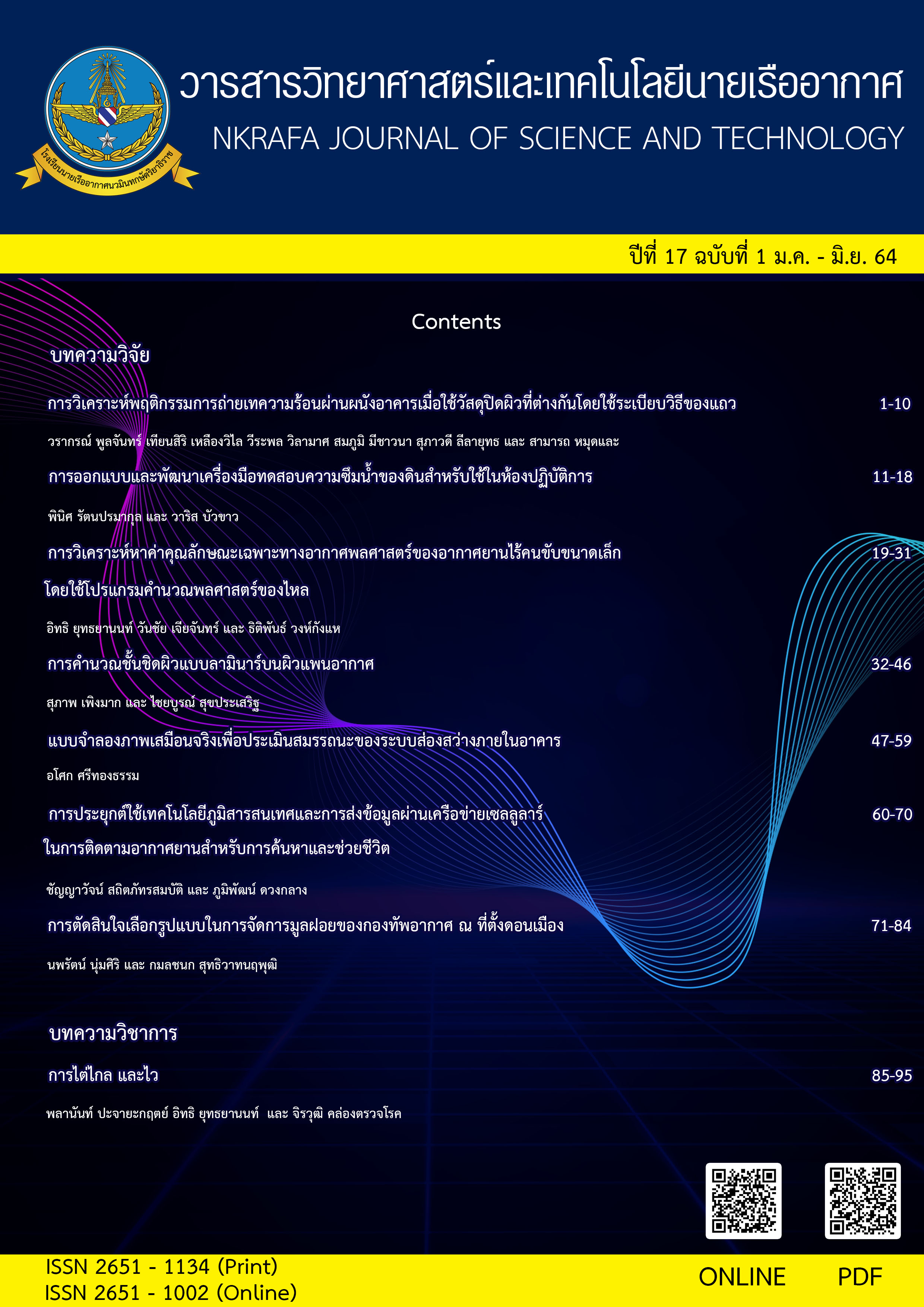The Computer Simulation to assess the performance of the indoor lighting system.
Main Article Content
Abstract
This research presented the virtual simulated images for the building’s interior illumination by using Dialux 4.12 as a simulation software. The research objective was to evaluate illumination system’s performance inside the building by comparing of luminance, average illuminance uniformity and, light power density in 2 sample areas with different illuminance distribution from 2 types of lamp. Area number 1 installed 9 sets of lamp size 30 cm width and 120 cm length. Area number 2 installed 20 sets of lamp size 60 cm width and 120 cm length. The research result revealed that illuminance and light power density value in both areas were higher than standard criteria. However, only in the area number 2 which the average illuminance uniformity value was conformed with the standard. Therefore, researcher suggested the guideline for increasing illumination system performance from the result of the virtual simulated images in the area number 2 only. The performance improvement guideline is to decrease the exceeding value of illuminance and light power density which can be done by reducing 50% of lamp sets and maintaining the average illuminance uniformity value not less than 0.40 which result in reduction of energy consumption for illumination system 50% or from 129,800 watt per hour to 64,900 watt per hour. The result of the study can be summarized that using the virtual simulated images technique for conceptual design and improvement in illumination engineering is one of good alternates for increasing the energy consumption.
Article Details

This work is licensed under a Creative Commons Attribution-NonCommercial-NoDerivatives 4.0 International License.
- Content and information in articles published in NKRAFA Journal of Science and Technology are comment and responsibility of authors of articles directly. Journal editorial do no need to agree or share any responsibility.
- NKRAFA Journal of Science and Technology Articles holds the copyright of the content, pictures, images etc. which published in it. If any person or agency require to reuse all or some part of articles, the permission must be obtained from the NKRAFA Journal of Science and Technology.
References
[2] สมาคมไฟฟ้าแสงสว่างแห่งประเทศไทย. (2559). คู่มือแนวทางการออกแบบการส่องสว่างภายในอาคาร. กรุงเทพฯ: สมาคมไฟฟ้าแสงสว่างแห่งประเทศไทย.
[3] กฎกระทรวง. (2549). มาตรฐานในการบริหาร และการจัดการด้านความปลอดภัย อาชีวอนามัย และภาพแวดล้อมในการทำงานเกี่ยวกับ ความร้อน แสงสว่างและเสียง. สืบค้น 20 ตุลาคม 2563, จาก: http://www3.mol.go.th/content/63186/1505802871
[4] กฎกระทรวง. (2537). พระราชบัญญัติควบคุมอาคาร พ.ศ. 2522 ฉบับที่ 39 (พ.ศ. 2537). สืบค้น 15 ตุลาคม 2563, จาก:https://download.asa.or.th/03media/04law/cba/mr/mr37-39.pdf
[5] กฎกระทรวง. (2552). กำหนดประเภท หรือขนาดของอาคาร และมาตรฐาน หลักเกณฑ์ และวิธีการในการออกแบบอาคารเพื่อการอนุรักษ์พลังงาน พ.ศ. 2552. สืบค้น 10 ตุลาคม 2563, จาก: https://www.dede.go.th/download/energysaving58/20_2552.pdf
[6] กฎกระทรวง. (2562). ประกาศกรมสวัสดิการและคุ้มครองแรงงาน เรื่อง มาตรฐานความเข้มของแสงสว่าง. สืบค้น 10 ตุลาคม 2563, จาก: http://library.rsu.ac.th/greenoffice/law/law4_2.pdf
[7] เจริญ คันธวงศ์. (2555). การจัดการอาคารสำนักงานเพื่อการอนุรักษ์พลังงาน กรณีศึกษา อาคารเจริญ คันธวงศ์. มหาวิทยาลัยกรุงเทพฯ: มหาวิทยาลัยกรุงเทพฯ.
[8] ประภาศิลป์ อเนกสุวรรณมณี. (2555). การศึกษาความคุ้มค่าของโครงการเปลี่ยนหลอดไฟฟ้าเพื่อความมั่นคงด้านพลังงาน กองดุริยางค์ทหารบก. (ปริญญานิพนธ์บัณฑิตวิทยาลัย, มหาวิทยาลัยราชภัฏวไลยอลงกรณ์ ในพระบรมราชูปถัมภ์ ปทุมธานี).
[9] อวิรุทธ์ ศรีสุธาพรรณ. (2552). The Assessment of Building Energy Performance: Thammasat University, Rangsit Campus. Journal of Architectural/Planning Research and Studies. (1)6: 13-30.
[10] ศิวาวุธ ปิ่นอ่อน. (2553). การเพิ่มประสิทธิภาพการใช้พลังงานไฟฟ้าแสงสว่างพื้นที่ภายในและภายนอกอาคารศูนย์การค้าชุมชน : กรณีศึกษา ศูนย์การค้าลาวิลล่า. (วิทยานิพนธ์สถาปัตยกรรมศาสตรมหาบัณฑิต, มหาวิทยาลัยธรรมศาสตร์).
[11] วัลลภ ภูผา และคณะ. (2556). การศึกษาโคมไฟฟ้าแสงสว่างด้วยระบบพลังงานแบบผสมผสาน. ใน: การประชุมวิชาการเครือข่ายวิศวกรรมไฟฟ้า มหาวิทยาลัยเทคโนโลยีราชมงคล ครั้งที่ 5(657- 660). ประจวบคีรีขันธ์: เครือข่ายวิศวกรรมไฟฟ้า มหาวิทยาลัยเทคโนโลยีราชมงคล.


